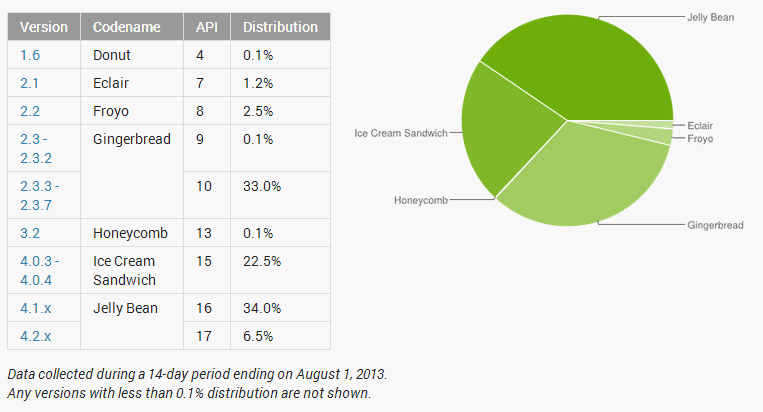It’s that time again folks, the time where Google releases the monthly Android distribution numbers, and things are really looking up for the Jelly Bean platform. When Google launched Android 4.1 Jelly Bean, they changed some significant parts of the base code and how Android works on the back-end. This resulted in a smoother, faster user experience that translates to the best possible way to experience Android. Since then Google has launched Android 4.2 and 4.3 with both keeping the Jelly Bean title. While many have wondered why Google would continue to “muddy the waters” with the Jelly Bean name, it’s a rather brilliant psychological decision on Google’s part. People aren’t as concerned now with whether or not they are on Android 4.1, 4.2 or 4.3, but rather just that they are on Jelly Bean, which is likely the purpose behind the naming decision. Let’s look at the breakdown here.
The numbers seen above represent phones actively visiting the Google Play Store, and since that’s the only way to legitimately get apps or any kind of app support on Android, it makes for an extremely accurate way to measure what people are using. We can see that Jelly Bean 4.1 is now the leader for any single version of Android, coming in at 34% of all Android devices. This is likely due to the huge number of Samsung Galaxy S III and Note II’s out there. Most of the time it seems like manufacturers who update a phone that was released with Android 4.0 Ice Cream Sandwich or lower, it’s updated to Android 4.1 Jelly Bean. This is also likely the reason for the much larger number of Android 4.1 devices out there. Android 4.2 continues to get ignored, and will likely be even more ignored as Android 4.3 was just recently announced. You’ll also notice a conspicuous lack of Android 4.3 even being mentioned on the table. This is likely because Android 4.3 hasn’t passed the 0.1% threshold that Google imposes on these stats.
Since only the Nexus line has been updated to Android 4.3 so far, the number of other Android devices in the world vastly outnumber the number of Nexus devices out there. Once Samsung and HTC start rolling out their Android 4.3 updates, expect this to change. We also see Android 2.3 Gingerbread continue to decline in numbers. This is absolutely excellent news, as it means people are now at the point where they are upgrading their old handsets for new Jelly Bean powered ones. Considering just how much better Jelly Bean is in overall user experience, this is great news for Android enthusiasts out there, as it means more and more people will have good experiences with our favorite mobile OS. Sony has detailed just how much Google has improved the Android update process with Android 4.3, so hopefully in just a few months’ time we’ll see that 4.3 number appear and significantly grow on this chart, unlike what 4.2 has seen.

